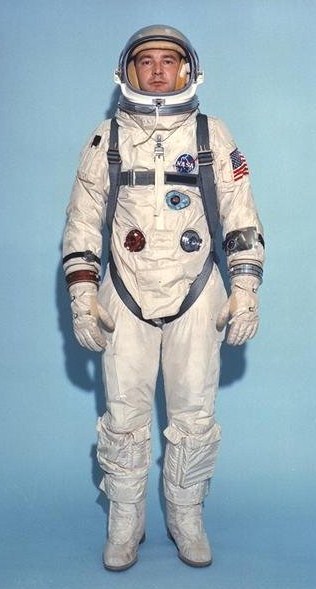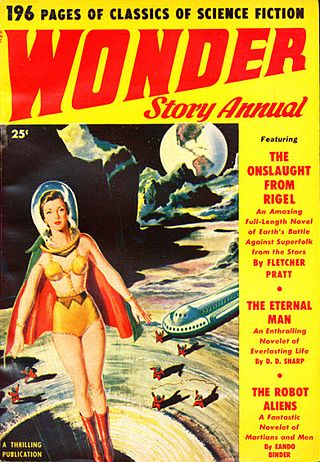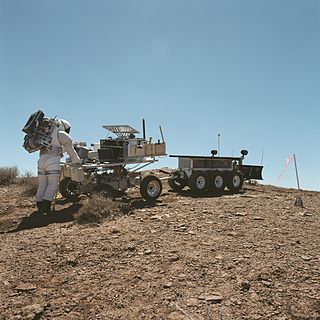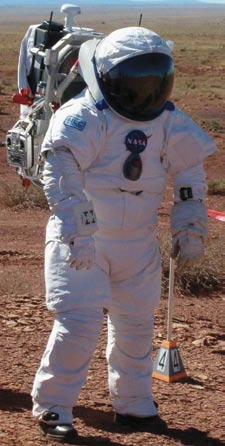
A space suit or spacesuit is a garment worn to keep a human alive in the harsh environment of outer space, vacuum and temperature extremes. Space suits are often worn inside spacecraft as a safety precaution in case of loss of cabin pressure, and are necessary for extravehicular activity (EVA), work done outside spacecraft. Space suits have been worn for such work in Earth orbit, on the surface of the Moon, and en route back to Earth from the Moon. Modern space suits augment the basic pressure garment with a complex system of equipment and environmental systems designed to keep the wearer comfortable, and to minimize the effort required to bend the limbs, resisting a soft pressure garment's natural tendency to stiffen against the vacuum. A self-contained oxygen supply and environmental control system is frequently employed to allow complete freedom of movement, independent of the spacecraft.

STS-69 was a Space Shuttle Endeavour mission, and the second flight of the Wake Shield Facility (WSF). The mission launched from Kennedy Space Center, Florida on 7 September 1995. It was the 100th successful crewed NASA spaceflight, not including X-15 flights.

A mechanical counterpressure (MCP) suit, partial pressure suit, direct compression suit, or space activity suit (SAS) is an experimental spacesuit which applies stable pressure against the skin by means of skintight elastic garments. The SAS is not inflated like a conventional spacesuit: it uses mechanical pressure, rather than air pressure, to compress the human body in low-pressure environments. Development was begun by NASA and the Air Force in the late 1950s and then again in the late 1960s, but neither design was used. Research is under way at the Massachusetts Institute of Technology (MIT) on a "Bio-Suit" System which is based on the original SAS concept.

The Extravehicular Mobility Unit (EMU) is an independent anthropomorphic spacesuit that provides environmental protection, mobility, life support, and communications for astronauts performing extravehicular activity (EVA) in Earth orbit. Introduced in 1981, it is a two-piece semi-rigid suit, and is currently one of two types of EVA spacesuits used by crew members on the International Space Station (ISS), the other being the Russian Orlan space suit. It was used by NASA's Space Shuttle astronauts prior to the end of the Shuttle program in 2011.

The Quest Joint Airlock, previously known as the Joint Airlock Module, is the primary airlock for the International Space Station. Quest was designed to host spacewalks with both Extravehicular Mobility Unit (EMU) spacesuits and Orlan space suits. The airlock was launched on STS-104 on July 14, 2001.

ILC Dover, LP is a special engineering development and manufacturing company, globally headquartered in Frederica, Delaware. ILC Dover specializes in the use of high-performance flexible materials, serving the aerospace, personal protection, and pharmaceutical industries.

The Apollo/Skylab space suit is a class of space suits used in Apollo and Skylab missions. The names for both the Apollo and Skylab space suits were Extravehicular Mobility Unit (EMU). The Apollo EMUs consisted of a Pressure Suit Assembly (PSA) aka "suit" and a Portable Life Support System (PLSS) that was more commonly called the "backpack". The A7L was the PSA model used on the Apollo 7 through 14 missions.

The Advanced Crew Escape Suit (ACES), or "pumpkin suit", is a full pressure suit that Space Shuttle crews began wearing after STS-65, for the ascent and entry portions of flight. The suit is a direct descendant of the U.S. Air Force high-altitude pressure suits worn by the two-man crews of the SR-71 Blackbird, pilots of the U-2 and X-15, and Gemini pilot-astronauts, and the Launch Entry Suits (LES) worn by NASA astronauts starting on the STS-26 flight, the first flight after the Challenger disaster. The suit is manufactured by the David Clark Company of Worcester, Massachusetts. Cosmetically the suit is very similar to the LES. ACES was first used in 1994.

The Mercury space suit was a full-body, high-altitude pressure suit originally developed by the B.F. Goodrich Company and the U.S. Navy for pilots of high-altitude fighter aircraft. It is best known for its role as the spacesuit worn by the astronauts of the Project Mercury spaceflights.

The Gemini spacesuit is a spacesuit worn by American astronauts for launch, in-flight activities and landing. It was designed by NASA based on the X-15 high-altitude pressure suit. All Gemini spacesuits were developed and manufactured by the David Clark Company in Worcester, Massachusetts.

A primarylife support system (PLSS), is a device connected to an astronaut or cosmonaut's spacesuit, which allows extra-vehicular activity with maximum freedom, independent of a spacecraft's life support system. A PLSS is generally worn like a backpack. The functions performed by the PLSS include:

Science fiction authors have designed imaginary spacesuits for their characters almost since the beginning of fiction set in space.

A Hard Upper Torso Assembly, or HUT, is a central component of several space suits, notably Roscosmos' Orlan and NASA's Extravehicular Mobility Unit (EMU). The fiberglass HUT forms a rigid enclosure about the upper body of the occupant, providing pressure containment for this part of the body. The HUT incorporates structural attachment points for the arms, Lower Torso Assembly (LTA), helmet, chest-mounted Display and Controls Module (DCM), and Primary Life Support Subsystem (PLSS) backpack.

The Mark III or MK III (H-1) is a NASA space suit technology demonstrator built by ILC Dover. While heavier than other suits, the Mark III is more mobile, and is designed for a relatively high operating pressure.

The Krechet-94 is a space suit model developed for lunar excursion during the Soviet crewed lunar program. It was designed by NPP Zvezda. Development began in 1967, concurrently with the Orlan suit for microgravity spacewalks. The developmental model was known simply as Krechet.

NASA's Desert Research and Technology Studies is a group of teams which perform an annual series of field trials seeking to demonstrate and test candidate technologies and systems for human exploration of the surface of the Moon, Mars, or other rocky bodies.

The Constellation Space Suit was a planned full pressure suit system that would have served as an intra-vehicular activity (IVA) and extra-vehicular activity (EVA) garment for the proposed Project Constellation flights. The design of the suit was announced by NASA on June 11, 2008, and it was to be manufactured by Houston, Texas-based Oceaneering International, the 4th company after the David Clark Company, Hamilton Sundstrand, and ILC Dover to produce life-support hardware, as a prime contractor, for in-flight space use.

The Launch Entry Suit (LES), known as the "pumpkin suit", is a partial-pressure suit that was worn by all Space Shuttle crews for the ascent and entry portions of flight from STS-26 (1988) to STS-65 (1994). It was completely phased out by STS-88 and replaced by the ACES suit. The suit was manufactured by the David Clark Company of Worcester, Massachusetts.

Final Frontier Design is a seed-stage startup company that builds and tests spacesuits. The company's products both enable, and are enabled by, the more recent lower-cost access to space epitomized by NewSpace launch companies such as SpaceX, Virgin Galactic and XCOR Aerospace. FFD was awarded a Phase I SBIR in 2011 and developed pressure garment glove technology under this contract.

The Z series is a series of prototype extra-vehicular activity (EVA) space suits being developed in the Advanced Extravehicular Mobility Unit (AEMU) project under NASA's Advanced Exploration Systems (AES) program. The suits are being designed to be used for both micro-gravity and planetary EVAs.




















